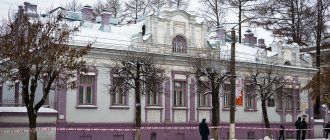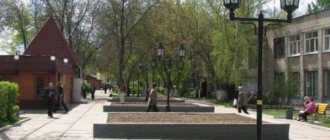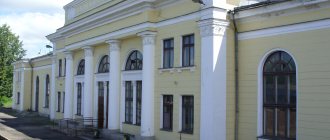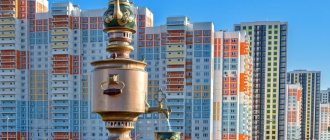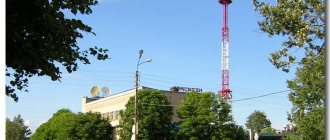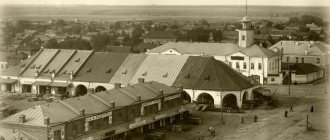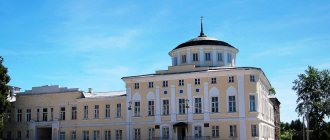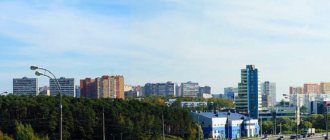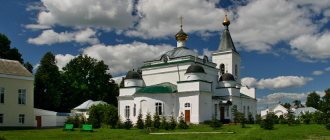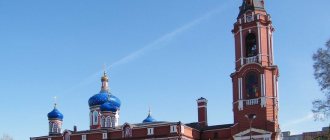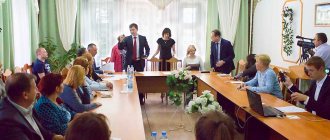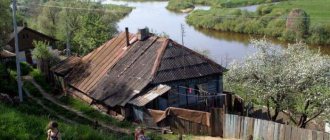The history of the emergence and development of the city of Kirov
The location of modern Kirov is the southern slopes of the Smolensk-Moscow Upland. The Bolva River flows nearby. The Pesochnya River flows into it. The city has 2 reservoirs - the Upper, formed after the construction of the dam, and the Lower, located within the city.
Archaeological finds prove the presence of human settlements along the banks of the Bolva River back in the Stone Age and settlements in the ancient and Middle Ages. And now there are mounds telling about the battles of the 13th-14th centuries.
Ivan III in his spiritual letter mentions the village of Fominichi. In various chronicles there are records of wooden churches of the 16th century, and of a monastery in Berezhki, operating in the 17th century.
The village of Pesochnya appeared in 1745. The name is associated with the nature of the soil and the river. Then the Zolotarev merchants created a metallurgical plant that produced cast iron dishes, oven castings, and nails. Four years later, ownership of the enterprise passes to the great-grandfather of Natalya Goncharova (Pushkin’s wife) - Afanasy Goncharov. He and his heirs owned it for 90 years. During this time, the following appeared in the village:
- Church of the Nativity of the Blessed Virgin Mary made of stone;
- plant management, consisting of 2 floors;
- house at the estate;
- new factory buildings - sawmill, nail factory.
In 1839, the Pesochensky factories were acquired by Ivan Maltsov. The Upper Plant continued to produce kitchen and stove castings. And the Nizhne Pesochensky Hammer Plant was repurposed for the production of earthenware dishes. Local white refractory clay was used to make it.
This is what the faience factory looked like
Sergei Ivanovich Maltsov, the owner of industrial enterprises, played a huge role in the history of Russia. His many actions surprised contemporaries and historians:
- During the years of serfdom, corporal punishment was not used against its peasants.
- Houses were built for them at the expense of the owner.
- In hard jobs, people worked 8 hours a day. This has never happened in Russia before.
- Maltsov financed the opening of educational institutions and hospitals.
His contribution to the creation and development of railways and railway engineering in Russia is enormous. On trips to Europe, he was interested in new products in this industry. He then met with Emperor Nicholas I and presented his projects to him. He proposed to involve exiles in the construction of railways. He created several railway projects. In addition, he put forward the idea of creating rail rolling plants in Russia. Then, one of his factories begins to produce steam locomotives and carriages.
The middle of the 19th century was the time of construction of stone houses on Bolshaya Pesochnya Street. Currently it has been renamed Proletarskaya. This street connected two factories and the villages created by them. But the division of the city into Upper and Lower exists even now.
A narrow-gauge railway appeared in Pesochnya in 1881. It connected the village with Bryansk and Dyatkovo. Not only freight trains moved along this road, but also passenger trains. Passengers were transported along it until 1932, when the Fayansovaya station was opened. Later the road was destroyed. A very small section has been preserved for the transportation of goods from the Kirov plant to Fayansovaya station.
Next to the iron foundry there was a station (wooden building), a room for steam locomotives and an extension for the locomotive crews to rest. With Maltsov's participation, an enamel factory was built.
Since 1936, the village of Pesochnya was given the status of a city and given the name Kirov. During the Great Patriotic War, the city's industry suffered greatly - some enterprises were evacuated to the rear, and the remaining factories suffered enormous damage. It was necessary to rebuild damaged residential buildings, restore communication lines for power, water and heat. The city is divided into 4 microdistricts:
- Upper;
- Lower;
- Earthenware;
- Zhilino.
A workers' settlement near the Fayansovaya railway station served as the basis for the creation of a microdistrict with the same name. It is separated from the city center by the Bolva River. A significant part of industrial and transport enterprises are located in the northern part of the microdistrict.
There is no industrial production in the Zhilino residential area. This is a picturesque area with one-story buildings and natural landscaping. In terms of economic benefits, the city is not in a particularly advantageous location, since there is no direct connection with Kaluga and Moscow. So, for example, from Moscow Kirov is located at a distance of 250 km in a straight line, by highway - 285 km, and by railway - 333-383 km. But through the main railway St. Petersburg - Donbass the city has connections with Bryansk, Murmansk, cities of Southern Ukraine and Crimea.
The connection between the city and the lives of famous people
The lives of many famous people are closely intertwined with Kirov:
- In 1966, Yuri Gagarin visited it.
- Maxim Goretsky, a Belarusian scientist and writer, lived there for the last 2 years of his life. He worked as a teacher of Russian language and literature at secondary school 1.
- The first president of the Chechen Republic, Dzhokhar Dudayev, had his first meeting with his future wife while serving in the Shaikovka garrison.
- Konstantin Bushuev, a well-known scientist in the rocket science industry, graduated from the Pesochensky Industrial College.
Natives of this area are Demichev (former Minister of Culture), Chistyakov (children's writer), Ovsyankin (sculptor), Eremenkov (participant in the First World War, the Civil War and the Great Patriotic War).
Ancient Rus'
Man lived along the banks of the Neruch, Uzhat, Bolva rivers and their tributaries already during the Mesolithic period - 15-20 thousand years ago.
On the territory of the region there are archaeological monuments: sites of the Stone Age (Mesolithic, Neolithic), settlements of the early Iron Age, settlements of the period of Ancient and Medieval Rus', and some objects, for example, burial grounds of the period of Ancient Rus', contain several, or even more than a dozen embankments, i.e. are complex, group monuments. In the 12th-13th centuries, the territory of present-day Kirov was part of the Bryansk Principality and was the border of Russey and the Principality of Lithuania. On the banks of Bolva and Pesochenka, mounds are still preserved - silent witnesses to the battles of the 13th-14th centuries. The origin of some settlements in the region goes back to ancient times: the village of Fominichi is mentioned in the spiritual charter of Ivan III in 1504, in the village of Berezhki in the 17th century. a monastery operated, and in the villages of Anisovo Gorodishche, Voskresensk, Slobodka already in the 16th century. wooden temples are mentioned.
The city arose in 1744-1745, when on the banks of the Pesochenka River in the Fominichsky camp of the Serpey district of the Kaluga province, enterprising merchants Ivan and Peter Zolotarev founded a small metallurgical production. The foundation of the plant, which later became known as the Verkhne-Pesochensky iron-making and hammer plant, began in the summer of 1744, and this event served as the basis for calculating the current city from there. The founding date of the plant is December 2, 1745, when the blast-furnace foundry was launched and the first cast iron products were molded. In addition to the production of cast iron utensils and furnace casting, part of the cast iron was converted into iron, and a large number of different products were made from it: from strip iron and nails to machine parts and mechanisms.
Upper Lake
Locals are very proud of their Lake Superior. Although it would be more correct to call it a reservoir. It was formed after the creation of a dam on the Pesochnya River. Its area is 215 hectares.
The lake is a favorite place for locals, especially in the summer.
It is suitable for swimming. Its bottom is sandy. Artists are attracted to this place by its beautiful landscapes.
Alexander Zoryukov created more than one painting near the shores of the lake. One of them is “Bay on Lake Superior”
Unfortunately, the mansion that belonged to the Goncharov family, which stood on the shore of the lake, has not been preserved.
Covid emergency room
I couldn’t get dressed at home on my own to go out with the doctors and go to the CT scan. I also don’t remember well how I left my apartment on the fifth floor to the ambulance. Every second I was afraid of collapsing on the steps. But the doctors were in no hurry, closely watched over me, and supported me. Thanks to them.
A few minutes later, and I was driving in the ambulance in a fog, I was taken to the fourth hospital. It has been completely converted into one large infectious diseases department. Residents of new houses and an elite low-rise residential complex located in close proximity to this medical institution hardly dreamed of such a neighborhood. But in Bryansk, new residents rarely think about “neighbors” and the future social infrastructure around their future homes.
In the waiting room of the reception room I was asked to fill out a couple of consent papers, some questionnaires, something else. There was no strength for anything. How to put shoe covers on sneakers. The paramedic who delivered me helped with this too, special thanks to her for that. It's a pity I don't know this woman's name. The peculiarity of being sick with Covid: you see only the eyes of all your saviors and unexpected helpers. They, the eyes, are the only thing that the protective white suits do not hide.
Soon I found myself on the table of a CT scan machine. It seemed to be low, but even climbing onto it in the monstrous condition that Covid “gives” turned out to be quite a problem. When I had a second CT scan, a control scan, before discharge, it turned out that the operator, a kind and caring woman with a soft voice, remembered me: “Be careful, sit on the table, please, and stretch out. Don't crash. The first time you almost succeeded." He asked: “Do you remember what state I was in?” - "Like yesterday. Head here, closer, so... Legs, yeah, good. We cross our arms and lay our heads like this. Now let's ride around a little, like on a swing. Cover your eyes."
A repeat CT scan showed “pneumonia in the resolving stage.” This means that the cloudy glass is gone or almost gone, and recovery has begun. But the result of the first CT scan was not at all pleasing...
Three minutes of buzzing overhead, orders coming from somewhere above: “Inhale and hold your breath!”, “Breathe!”, “Don’t breathe!” - and here I am again in the corridor. I sit and think about how I will get back home. I couldn’t believe at all that everything could be unimportant for me. I didn’t even want to lie down in a hospital bed. Adequacy of thinking during “corona” - forget it.
The CT operator was reluctant to answer my questions. She saw the big picture, of course. But she is not supposed to comment on the examination results. This is done by the doctor in the emergency room. He also turned out to be a courteous and intelligent man. He immediately asked me: “Are we going to go to bed?”
Like a fool, I also asked him through the veil of gray haze in my eyes and barely sitting on the couch: “Do you really need to go to bed?” It turned out that there were no options: “KT-3, moderate severity.” The incidence of cloudy glass lung damage is close to 60%, and maybe more. Viral pneumonia. A little more and resuscitation.
The doctor unexpectedly offered three options for hospitalization, explaining that such an opportunity was rare. Usually all alternatives are limited to one option. But I didn’t actually ask for options. Not in my condition.
“Well, where are you going? — the doctor asked me, simultaneously calling someone. “To the second city hospital, in Glinishchevo, the Bryansk district hospital, or are we staying here, in the fourth?” Why I had this choice, I myself did not understand. He replied that it was at his discretion. I honestly didn't care at all. I just wanted to fall somewhere and lie there stupidly.
The doctor looked at my documents again and said to someone on the phone: “He is from the Sovetsky district of Bryansk, that is, from here. What's the point of taking him somewhere else?" The doctor's interlocutor, unknown to me, also apparently decided so. Parting with the good doctor (it was clear from everything that everyone here respected him), I casually asked: “What about my two Sputnik vaccinations?” Didn’t work, it turns out?” The doctor, as I understood it, grinned philosophically into his mask and did not say anything good. He just remarked: “There are plenty of people like you here, with vaccinations.”
This turned out to be true. All future roommates were vaccinated too. Like most of the 60-odd other patients who were on my future, fourth floor, it seems. Nurses later repeated one after another that “unvaccinated people often go straight to intensive care.” Perhaps this is what we should say now.
Monument to the lumberjack foreman
If you want an interesting photo, take it near this statue. Its uniqueness will attract the attention of your friends.
Monument to a lumberjack painted as a foreman
It turns out that the role of this sculpture is to advertise a house-building plant. It serves as a pointer to it. Initially, it looked quite simple - a figure made of gray concrete, somewhat reminiscent of a woodcutter from the book “The Wizard of Oz” or a robot. Later the monument was modified. The artists of the Rudnev brothers had an idea - to transform the standing figure into a foreman. Soon he had a name - Felix.
Driving into Kirov from Moscow, you will see this statue. It is installed on Stepan Razin Street in front of the dam.
Onset of the disease
The self-prescribed antibiotic that was in the home medicine cabinet did not help either. A doctor friend found out about this. “Sasha, it’s time to call an ambulance, this is rubbish,” was his morning verdict on September 17. Bryansk was preparing to celebrate City Day, and I was preparing for the arrival of the ambulance. Although I still resisted for several hours, until I asked my wife to dial 03 on the phone, I no longer had the strength. Why did you resist? Don't ask, I don't know.
Closer to noon I realized that everything was unbearable. The lady who took calls in the ambulance was not very kind - she was indignant that they went straight to them, and not to the clinic. Explanations that the temperature had been high for several days and other “joys” did not make her any softer. The ambulance arrived a little over three hours later. They say that this is not so bad in modern times.
A paramedic examined me, and her assistant stood next to me. Both were in full “coronavirus” gear. However, later, having already seen enough in the hospital at the doctors and nurses packed from head to toe, I realized that the doctors who arrived by ambulance were not protected from infection at all. Instead of real anti-plague suits, they wore white “construction” coats with large mesh. So that it was, apparently.
But at that moment it was interesting and creepy to look at them at the same time. Even through the veil of illness and the rapidly overwhelming powerlessness. I was given an antipyretic injection. It became a little easier. I was able to answer in the affirmative that I would go for a CT scan. The smart wife packed a bag with the essentials in advance, including a large bottle of water.
I used to hear from other patients that people with Covid have constant problems with bottled water. Relatives do not always accept parcels, and such establishments do not have coolers. But the problem with water is apparently a thing of the past. Looking ahead, I will say that in the Covid situation where I was lying - in Bryansk City Hospital No. 4 - they were fully supplied with water. Bottles of non-carbonated mineral water from the radiation-laden southwest of the Bryansk region were always displayed on the refrigerator in the common corridor.
I wanted to drink constantly during Covid. I personally blew out 1.5–2 liters of mineral water per day; my roommates could drink up to 3 liters. But this does not count, as a rule, two glasses of unsweetened tea or compote, which I regularly took for breakfast, lunch and dinner. And half a bottle or even a whole kefir, which I also drank during the day. But I still didn’t get drunk: this is such an infection - Covid...
Smolovsky cult stone
The Smolovka forest area attracts tourists with its huge stone temple. A temple is a sanctuary, a place where services were held and all kinds of rituals were performed.
According to an ancient legend, human sacrifices were performed at this stone.
It is all painted with ancient signs - runes. A significant part of them is poorly visible. There is debate about the origin of these signs:
- Early Christian myths explain their origin as “the traces of the Virgin Mary.”
- Other assumptions are that they are the first letters of the names of people who became victims of rituals.
In order to study them, you need to clean the overgrown covering of the block. There is more than one such “special stone” in the Kaluga region, but the boulder from Smolovka is the largest of them. Next to him lay another stone, smaller in size. But in the 50s he was taken to an unknown direction. This event is attributed to the fight against superstitions.
You can get to the stone by walking along the alley from Academician Frolov Street to Chkalov Street.
Self-deception and hope
Immediately with this infection, called in different ways either “corona”, then “covid”, or simply coronavirus (the official name is much longer), few people end up in the hospital. Although now, unlike last year, people are admitted to hospitals,6 according to official statements, even with mild forms of the disease. But in practice, everything turns out a little more ornate.
For many, Covid, as I have seen from my own and other people’s examples, begins as a banal ARVI or acute respiratory infection. In other words, a “cold.” One “got cold” by running out into the street at lunchtime, lightly, another “got cold while fishing”, the third took a relatively long time (everything happens quickly with the coronavirus) and stubbornly believed that he had contracted pneumonia, which was well known from childhood...
Few people immediately realize the seriousness of the disease. And many do not have time to do this at all. But I was lucky. Also at first, for four days without understanding what kind of viral “cake” I had entered into, I was treated symptomatically. And a little more with my favorite strong alcoholic drink - I disinfected myself from the inside, so to speak. I rinsed my mouth and throat and killed germs in my stomach.
Nonsense, of course. But I wanted to believe in this. I didn’t want to think that everything was much more serious. In the spring, after all, everything had already happened: the smell disappeared, the taste sensations of food and products changed monstrously, and bronchitis worsened. Well, I kind of got over it, and it couldn’t happen again. There should have been antibodies.
However, why am I... In the spring, no one officially put anything to me. It’s purely my thoughts that I was sick with “corona” back then. Actually, after a while, and after my wife got injected, I also decided to get vaccinated. The same two-component and vaunted one, which was named in a cosmic manner.
In the spring the cough was dry, sometimes barking, but not significant. I attributed it to my chronic bronchitis. Yes, there was weakness, but whoever hasn’t experienced it during ARVI or ARVI, let him be the first to throw paracetamol at me. By the way, it only saved me from high fever for an hour or two. It was impossible to knock her down at home, while this time I was lying flat at home for the first four days in front of the hospital.
At the same time, I was constantly breaking out in incredible sweat, both in the spring and now. Cold and incredibly sticky. Usually after this it becomes easier. But this time it wasn't like that. The sheets, blankets, T-shirts that were changed many times, and the pillow became wet so quickly that there was a complete feeling of being in the pool. It was stressful, but still my brain refused to believe that something terrible had happened. That here it is, your personal huge cow patty of misfortune.
Two churches of the Nativity of the Blessed Virgin Mary
When talking about a church with this name, it should be borne in mind that there are several of them in Kirov. Therefore, there is often confusion about their location. One of them is the oldest surviving church in the city. It was erected in 1768 with funds allocated by Ivan Goncharov, the owner of an iron foundry. The brick building was built in the style of provincial classicism. Later it was subject to restructuring. Under Maltsov, a clock was installed on the upper tier of the bell tower. After the temple was closed in 1932, the bell tower and the top of the building were demolished, and the apse was replaced with a new extension. The building was visited by: House of Culture, House of Pioneers, cinema, shops. But in the end it was returned to the believers.
This is what the church looks like now
Its location: Factory Square.
Another church is located in the city cemetery. Outwardly, it looks simple - like a village hut. However, its popularity is great.
This is an ordinary plank building in the shape of a rectangle.
There is a belfry nearby. The temple has a complicated history. The date of its creation is 1907. After the destruction and closure of other churches, for a long time it remained the only place that received believers.
It was closed in 1932. But until 1948, services were held in a small wooden chapel without windows measuring 10*10 meters. The building was not heated. Then an extension was added. The area has doubled. Believers petitioned various authorities for the return of the church building, where the finance department was located. Since 1956, after restoration, divine services have resumed there.
Address: Kirova street, 48.
Sergei Mironovich Kirov
Soviet statesman and political figure Sergei Mironovich Kirov (real name Kostrikov) has been a member of the RSDLP since 1904 (the official version, according to other sources, from 1919, was a Menshevik before that). The pseudonym “Kirov” is from the name Kir. In April 1912, the Terek newspaper published an article “Across the Road,” signed “S. Kirov". Under this pseudonym he entered the history of the USSR. He sympathized with the Mensheviks and supported the Provisional Government. In 1919 - Chairman of the Provisional Revolutionary Committee in Astrakhan, suppressed a workers' "counter-revolutionary" rebellion, shot a religious procession, oversaw the arrest and execution of Metropolitan Mitrofan of Astrakhan and Bishop Leonty.
In 1920, as part of the XI Red Army, he entered Baku, became a member of the Caucasian Bureau of the Central Committee of the RCP (b), in June 1920 he was appointed plenipotentiary representative of Soviet Russia in Georgia, in March 1921, as part of the Soviet delegation, he participated in the conclusion of a peace treaty with Poland in Riga . 1921 - First Secretary of the Central Committee of the Communist Party of Azerbaijan, 1923 - elected member of the Central Committee of the RCP (b).
In 1926, S. M. Kirov was elected first secretary of the Leningrad Provincial Committee (regional committee) and the city party committee and the North-Western Bureau of the Central Committee of the All-Union Communist Party of Bolsheviks. The main task is to suppress the “Zinoviev” opposition. Since 1927, he became the first secretary of the regional committee of the CPSU (b). Under Kirov, a large number of churches were demolished in Leningrad; S. M. Kirov was one of the initiators of the pogrom of scientists of the Russian Academy of Sciences. During passportization, thousands of former nobles were forcibly evicted from Leningrad. “The Cheka-GPU is a body designed to punish, and if we simply depict this matter, not only to punish, but to really punish, so that in the next world the population growth will be noticeable, thanks to the activities of our GPU” - from a speech at the celebration of the 15th anniversary of the Cheka-OGPU in 1932. He is in charge of the construction of mining plants on the Kola Peninsula for the extraction of apatite, the White Sea-Baltic Canal and SLON - the Solovetsky Special Purpose Camp of the OGPU.
By 1934, S. M. Kirov was awarded the Order of Lenin for outstanding services in the restoration and reconstruction of the oil industry. He has been a member of the Politburo of the Central Committee of the All-Union Communist Party of Bolsheviks since 1930, and since 1934 secretary of the Central Committee of the All-Union Communist Party of Bolsheviks. On December 1, 1934, he was shot in the back of the head in Smolny.
Just a few days after the murder, the city of Vyatka was renamed the city of Kirov (and S. M. Kirov himself had never been to the city of Vyatka). Then, over the course of several years, the USSR began mass renaming of cities (Kirovograd, our Kaluga Kirov, Kirovgrad, Kirovo-Chepetsk, four Kirovsk, Kirovskoye), streets and squares of cities, factories (the most famous are the Kirov Factory and the First State Watch Factory named after Kirov in St. Petersburg), educational institutions (the most famous are the S. M. Kirov Military Medical Academy and the S. M. Kirov Kazan Institute of Chemical Technology), stadiums, palaces of culture, parks, metro stations in Moscow and St. Petersburg, districts and microdistricts.
Read more: Sergei Mironovich Kirov: biography of the executioner
A monument to Kirov was erected in Kirov, Kaluga region.
Alexander Nevsky Cathedral of Kirov
This temple ranks 2nd in Kirov by date of construction (1890). But in terms of grandeur and beauty, it is on the first step. Its construction lasted for 7 years. The sponsors were wealthy residents and craftsmen of the village of Pesochensky Zavod. Industrialists Maltsov made a significant contribution. The building is 53 m long and 16 m wide. According to its layout, it can be divided into 3 parts:
- a central cube-shaped part with a towering rotunda covered by a hemisphere;
- refectory;
- bell tower of 2 tiers.
The structure is surrounded by a wide smooth frieze and a crowning stepped cornice. The windows on the rotunda (16 pieces) emit a lot of light into the building. The painting of the dome inside was done by a painter from the Perebrovshchikov faience factory. 17 frescoes were full of full-length images of Jesus Christ, apostles, and saints. They have not been preserved to this day.
Since 1891, there was a parochial school at the temple. The building erected for it (1907) survived. It houses the Sunday School.
After the building was transferred to the factory club, it underwent reconstruction, which distorted the architectural design of the cathedral. Work was carried out to plaster the walls, fill in some windows, eliminate decorative facades, and add an extension. The refectory was turned into an auditorium, and a library was placed in the central part.
By 1990, the building had fallen into disrepair. We managed to find drawings for the construction of the temple. Since then, work began on its restoration:
- carried out dismantling of partitions, interfloor ceilings and stairs; the central dome was covered with galvanization, a drum with a cross and a dome was installed;
- they covered the roof over the altar;
- replaced the doors with oak ones, the windows of the temple, refectory and rotunda;
- laid floor tiles;
- equipped with heating;
- We manufactured and installed a new iconostasis with wooden carvings by local craftsmen.
2012 is the time for the creation of a new bell tower instead of the extension added during the Soviet years. A team of workers from JSC Kirov Stroyfarfor, later renamed Kirov Ceramics, took an active part in the restoration of the cathedral.
Exterior view of the Alexander Nevsky Church
Cathedral address: Proletarskaya street, 244.
The Great Patriotic War
New production and social facilities are being built: already before the war there were four secondary schools in Kirov. Kirov enterprises are switching to the production of sanitary products.
Since 1937, Kirov and the Kirovsky district became part of the Oryol region.
A month after the start of the war, on July 27, 1941, the Smolensk Regional Committee of the All-Union Communist Party of Bolsheviks adopted a resolution “On the resettlement of workers and employees of the iron foundry and earthenware factories of the city of Kirov and the Fayansovaya station, their families to the rear regions of the country,” according to which about 10 thousand Kirov residents were to be evacuated to the Sverdlovsk, Novosibirsk and Chelyabinsk regions. According to this decree, the Kirov district party committee and the district executive committee developed a plan for evacuation and destruction in the event of the occupation of material assets at the earthenware factory and other enterprises of the city (industrial plant, raipo, district trade, bakery, printing house, iron foundry). Often in the summer days of 1941, the plant was bombed by enemy planes, so it was simply dangerous to work there in July-September. Despite this, dismantling of the equipment was in full swing, which was loaded into wagons and sent to the Urals, in the city of Irbit, Sverdlovsk Region (now this is the Irbit Glass Factory Limited Liability Partnership). Director Dmitry Fedorovich Ermilov led the evacuation of the plant to the city of Irbit, but he himself was left to work underground behind enemy lines. After the liberation of Kirov in January 1942, he was again appointed director of the enterprise and served as director for several months. In the summer of 1942, he was illegally repressed on trumped-up charges and spent two years in prison. Then he was released and took part in the war at the final stage. After the war he worked at the Fayansovaya railway junction.
Hitler's troops of Army Group Center broke through the Soviet defenses on the Desna on September 30 and three days later reached the territory of the Kirov region. The evacuation of civilians, organizations and institutions, which previously took place as planned, turned into a stampede. On October 4, 1941, the city was occupied by Nazi troops.
During the occupation, a hospital continued to operate in the city under the former leadership of Nikolai Ludvigovich Gernberger, which cured and saved more than one hundred and fifty soldiers of the Soviet army from certain death (on December 7, 1942, he was arrested by the NKVD on suspicion of collaboration with the Nazis, but managed to acquit himself).
After 98 days of occupation, the city and the eastern part of the region were liberated from the Nazis on January 10-11, 1942 by the troops of the 330th Infantry Division of the 10th Army of the Western Front (commander - Georgy Zhukov) during the Rzhev-Vyazma operation. They occupied the city without a fight. The Germans left Kirov without firing a single shot - the population cleared the roads for them, and they left on bicycles. The rifle and artillery regiments of this division defended the city and Fayansovaya from the enemy in 1942-1943. The strictest order was received from the front command: not to hand Kirov over to the enemy on pain of death. Two homemade armored trains were created and ran around Kirov. On February 14, 1942, the Germans began to advance towards the city itself, battles were already taking place on the outskirts and even on Lenin Street. They put the entire population of the city under arms and drove back the Nazis.
At the beginning of 1942, in the vicinity of Kirov (Pesochnya), the 2nd Cavalry Corps under the command of General was surrounded and suffered heavy losses. P. A. Belova and the 201st Airborne Brigade after a 5-month raid on enemy rear lines.
During the Great Patriotic War, Soviet commanders G.K. Zhukov, F.I. Golikov, I.V. Boldin, P.A. Belov, V.S. Popov stayed in Kirov.
In August 1943, the troops of the 10th Army liberated a significant part of the territory of the region. From August 10 to 20, as a result of the Spas-Demen offensive operation, the territory of the current rural settlements “Verkhnyaya Pesochnya” and “Tyagaevo” was liberated from the enemy. On September 15 of the same year, as a result of a flank attack on Bryansk by troops of the 50th Army, the settlements of the southwestern part of the region were finally liberated from the Nazis.
Both factories and other industrial enterprises were badly damaged, many streets were covered with craters from shells and bombs, courtyards and vegetable gardens were dug up with trenches, trenches and dugouts. Many residential buildings in the public and private sectors and public buildings were also damaged; communications (electricity, water, heat) were virtually absent. During certain periods of the war years, the plant's property was also stolen by the local civilian population and used by them for their own purposes. The city began to heal its wounds and return to peaceful life. Evacuated townspeople began to return and factories were restored.
More than 7 thousand Kirov residents took part in the Great Patriotic War, more than 5 thousand of them died, and 3 thousand civilians also died. The Kirov region gave Russia 9 Heroes of the Soviet Union and 3 full holders of the Order of Glory. There are 43 military graves (mass and single graves), 9,977 people are buried in them, the names of 8,160 people. known. In the city and region there are 40 other monuments and memorial sites related to the events of the war. Since 1998, the military memorial group “Poisk” has raised from the ground the remains of more than 2.5 thousand Soviet soldiers and commanders, the names of about 100 people have been established, Many have been found to have relatives who visited the graves of their dead fathers.
Kirov Museum of History and Local Lore
Every city has a museum dedicated to the history of the region. Kirov is no exception.
The museum was created in the building of a former cinema
Visitors are presented with exposition and exhibition halls. In the first room they get acquainted with ancient objects and historical documents of the Pesochensky region. In another room, various exhibitions are constantly organized.
The exhibition hall began its work in 1989. The first exhibition was dedicated to the works of Kosenkov, a Kirov landscape painter. Then the theme in this hall changed. Exhibitions were presented:
- historical and documentary with exhibits from the museum and private collections; works of children's creativity;
- wax figures;
- artists of the region;
- photo exhibitions.
The exhibition hall received its visitors in 1993. The museum's funds are constantly replenished. They number up to 19,000 storage units. Among them there are archaeological finds, numismatic and ethnographic objects, personal belongings, diaries of famous geologists, and original porcelain vases. Participating in the work of the museum are:
- archaeological expedition;
- clubs of collectors and embroiderers;
- employees of branches of scientific communities - geographical, literary, genealogical;
- public activists who help personally in the work of the museum or financially.
Those who want to learn more interesting facts can go on a tour of historical places and purchase books and paintings as souvenirs.
The museum is located at: Lenina Street, 1.
Modern Kirov
In 2004, during the administrative reform, the Municipal District “City of Kirov and Kirovsky District” was formed, consisting of one urban settlement “City of Kirov” and twelve rural settlements: “Berezhki Village”, “Malaya Pesochnya Village”, “Bolshie Savki Village”, “Village Verkhnyaya Pesochnya”, “Village Voloe”, “Village Voskresensk”, “Village Vypolzovo”, “Village Gavrilovka”, “Village Dubrovo”, “Village Buda”, “Village Tyagaevo”, “Village Fominichi”, united by a total territory of 1000 ,4 sq.km. The city of Kirov is a city of regional subordination and is not part of the district. Population as of January 1, 2009 – 43.3 thousand people.
In 2005, the Church of Xenia of Petersburg was built near the Fayansovaya station, and in 2006, construction began on the wooden Church of St. Nicholas the Wonderworker in the Zhilino microdistrict.
Architectural monuments and attractions: the churches of the Nativity of the Virgin (late 18th century) and Alexander Nevsky (1893). Near the villages of Prudki, Vyseltsy, Nagornoye and others, burial mounds of the Vyatichi and Krivichi (10th-12th centuries) were discovered. To date, as a result of the work of scientists in the region, 105 objects have been explored and studied to one degree or another, and 45 of them in 1994 were registered and protected as monuments of local (municipal) significance.
On the territory of the municipality there is a local history museum, which is staffed by the Pesochenskaya archaeological expedition, the military memorial group “Poisk”, a collectors’ club, and public museums (the fire protection museum in the professional fire station No. 40, the historical and archaeological museum of the pedagogical college of the city. Kirov, local history museum of the Resurrection Secondary School, etc.)
The historical information uses information from mycicerone.ru and kirmuseum.ucoz.ru.
Passions of the reception room
I was escorted to two lady receptionists. They weighed me there. It turned out that at home I lost about 6 kg during my illness. Unexpected joy.
While I was sitting and waiting for the registration (the doctor from the emergency room did not leave me with attention all this time, he encouraged me and said that I would definitely be admitted soon), I saw a lot. So, they brought two elderly people on gurneys in an ambulance. Already almost unconscious, as I understand it. One grandmother was 100 (!) years old without a few months. She was immediately sent to intensive care. The relatives were not given too much hope. Whether she is alive or not, I don’t know.
There were other serious patients. All of them were processed without me. I sat quietly on the couch, every now and then going into a semi-fainting state. With half an eye I saw how a thin pensioner brought his wife, she was already completely ill. It seems that at some point she literally slid from her chair in the hallway onto the floor.
But one young lady was lucky, apparently. A CT scan revealed nothing about her. She tried for a long time to get the results in her hands and go home. But in the organized and completely understandable chaos and turmoil that was going on in the emergency room, everyone was clearly not interested in her. Why she even came to this epicenter of coronavirus patients remains a mystery to me.
Doctors barely had time to “scatter” newly arriving patients. Ambulances drove up to the doors of the emergency room, it seemed, every five minutes... I was not mistaken. Later, from the window of the ward, every single day (and nights too - I had to sleep little by little) I observed how often ambulances brought new patients. There are really a lot of them.
In the next part I’ll tell you about the first hours in the ward, how I was injected with medicine for 60 thousand rubles, treatment, crowds of cockroaches and much more that they won’t tell about in the “Soviet press”...
